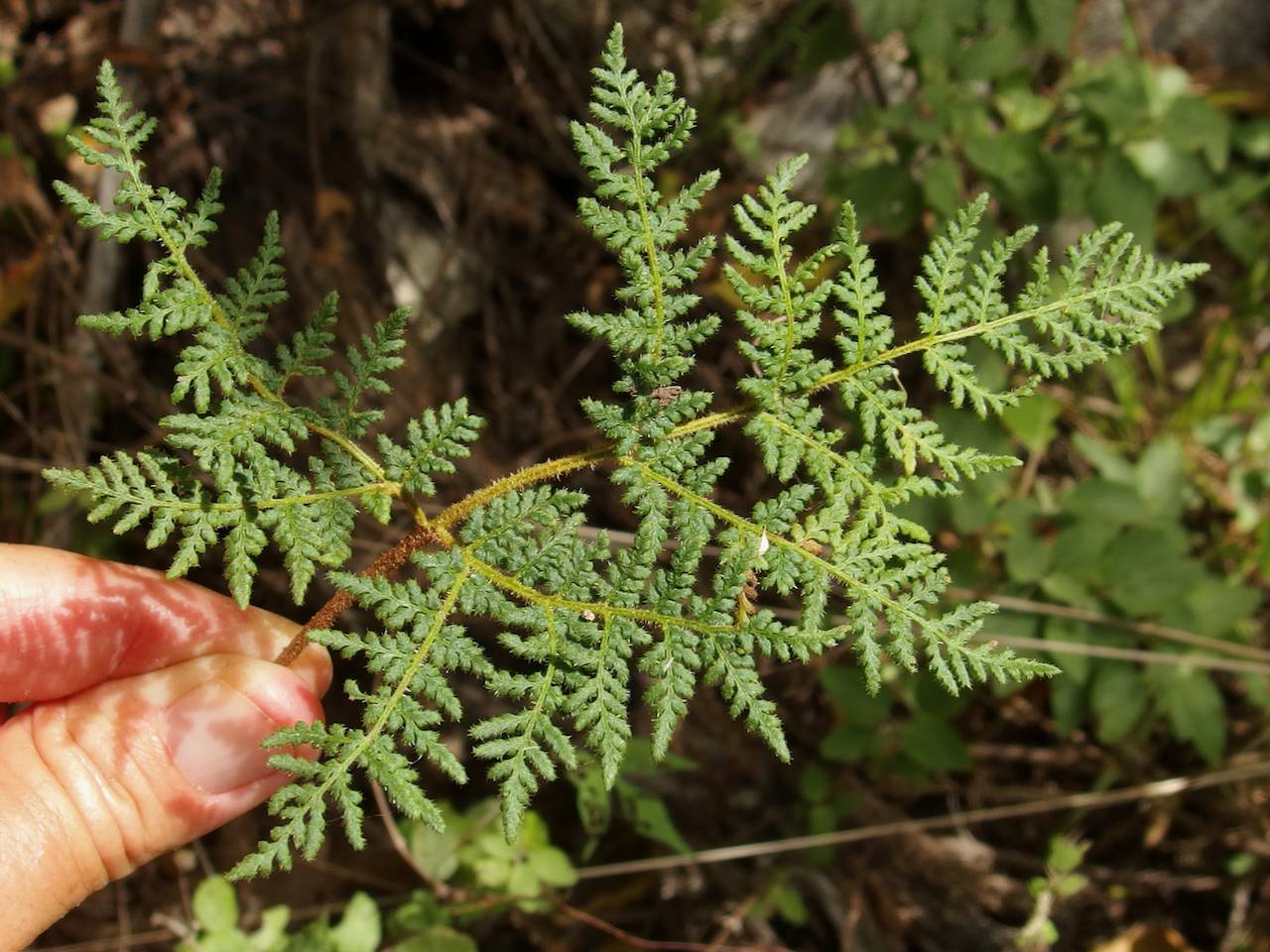
|
Family: Pteridaceae |
Plants usually on rock. Stems compact to long-creeping, ascending to horizontal, usually branched; scales brown to black or often bicolored with dark central stripe and lighter margins, linear-subulate to ovate-lanceolate, margins entire or denticulate. Leaves monomorphic, clustered to widely scattered, 4--60 cm. Petiole brown to black or straw-colored, rounded, flattened, or with single longitudinal groove adaxially, pubescent, scaly, or glabrous, with a single vascular bundle. Blade linear-oblong to lanceolate, ovate, or elongate-pentagonal, pinnate-pinnatifid to 4-pinnate at base, leathery or rarely somewhat herbaceous, abaxially pubescent and/or scaly, rarely glabrous, adaxially pubescent to glabrous, dull, not striate; rachis straight. Ultimate segments of blade stalked or sessile, usually free from costae, round to elongate or spatulate, usually less than 4 mm wide, base rounded, truncate, or cuneate; stalks (when present) often lustrous and dark colored; segment margins usually recurved to form confluent, poorly defined false indusia, extending entire length of segment or discontinuous on apical or lateral lobes. Veins of ultimate segments free or rarely anastomosing, pinnately branched and divergent distally. False indusia greenish to whitish, usually narrow, clearly marginal or rarely inframarginal, often concealing sporangia. Sporangia confined to submarginal vein tips or scattered along veins near segment margins, containing 64 or 32 spores, not intermixed with farina-producing glands. Spores brown to black or gray, rarely yellowish, tetrahedral-globose, rugose or cristate, lacking prominent equatorial ridge. Gametophytes glabrous. x = 30 (29 in Cheilanthes alabamensis complex). Cheilanthes is by far the largest and most diverse genus of xeric-adapted ferns. In its classic circumscription, the genus has been notoriously difficult to distinguish from other cheilanthoid genera, especially Notholaena and Pellaea (R. M. Tryon and A. F. Tryon 1982). This has led some authors (e.g., J. T. Mickel 1979b) to abandon several of the segregate genera and greatly expand the number of species assigned to Cheilanthes . Taxonomic problems in this group have motivated an ongoing series of biosystematic studies that offer hope for a stable classification through the identification of natural, monophyletic groups. The circumscription of Cheilanthes has been clarified recently by a redefinition of Notholaena and the transfer of several species (e.g., N . parryi , N . newberryi , and N . aurea ) to Cheilanthes (R. M. Tryon and A. F. Tryon 1982). The boundaries of the genus have been further sharpened by the recognition of Aspidotis (A. R. Smith 1975), Argyrochosma (M. D. Windham 1987), and Astrolepis (D. M. Benham and M. D. Windham 1992) as distinct genera. Despite these efforts, Cheilanthes remains a very heterogeneous (and probably polyphyletic) genus in need of further critical study. Lvs glabrous or more often evidently hairy or scaly, evergreen, uniform; petiole slender and wiry, dark and shining; lvs 2-4 times pinnate, the ultimate segments small, with clavate-tipped free veins; sori borne on the vein-ends just within the margins of the pinnules, often confluent, the point of attachment covered by the reflexed margins, which form a ±continuous, unmodified or partly scarious false indusium, but the mature sporangia often conspicuously exserted; small, ±xeromorphic rock-ferns, the rhizome beset with slender, brown to blackish scales. 100+, widespread, mostly New World. Gleason, Henry A. & Cronquist, Arthur J. 1991. Manual of vascular plants of northeastern United States and adjacent Canada. lxxv + 910 pp. ©The New York Botanical Garden. All rights reserved. Used by permission. |
This project was made possible in part by the Institute of Museum and Library Services [MG-70-19-0057-19].
Powered by Symbiota



